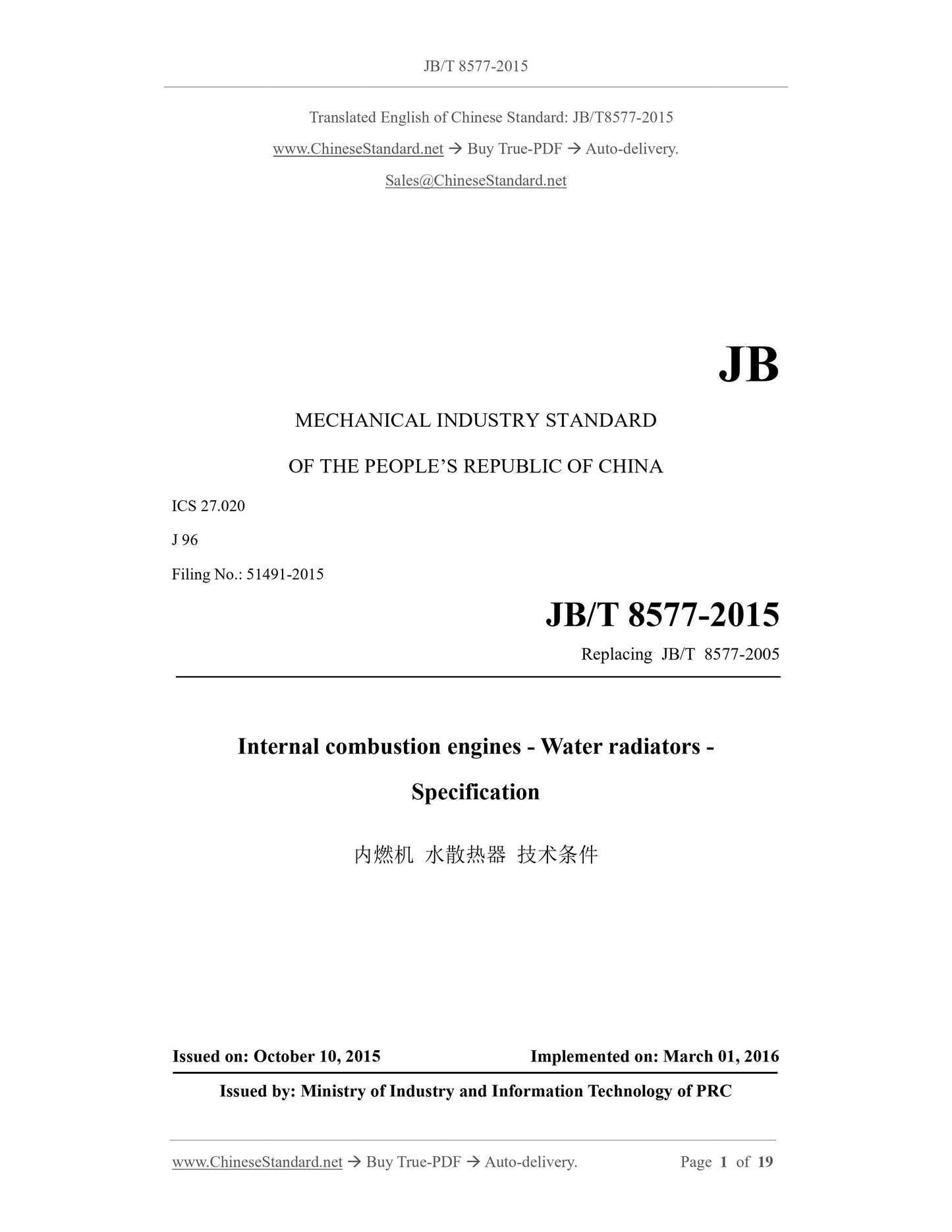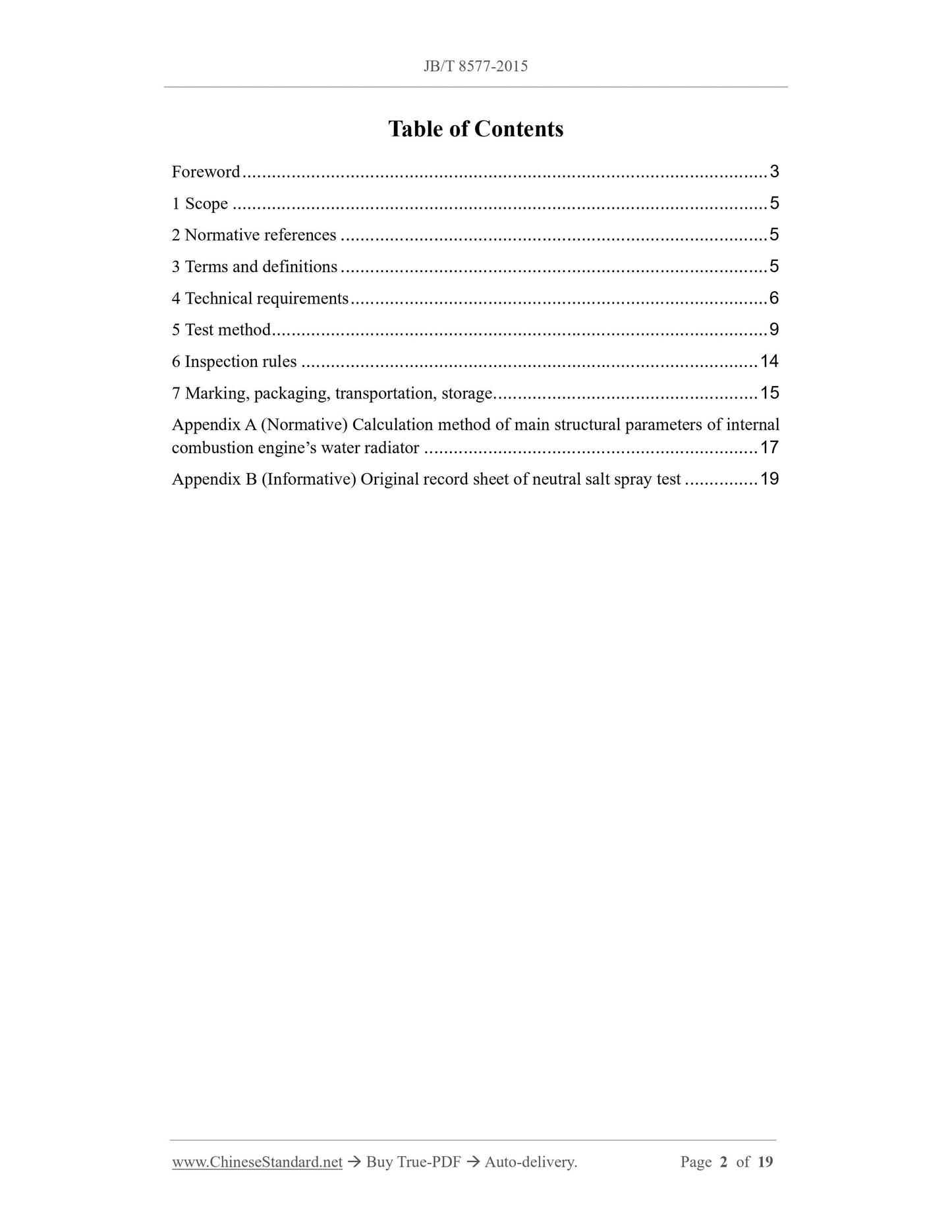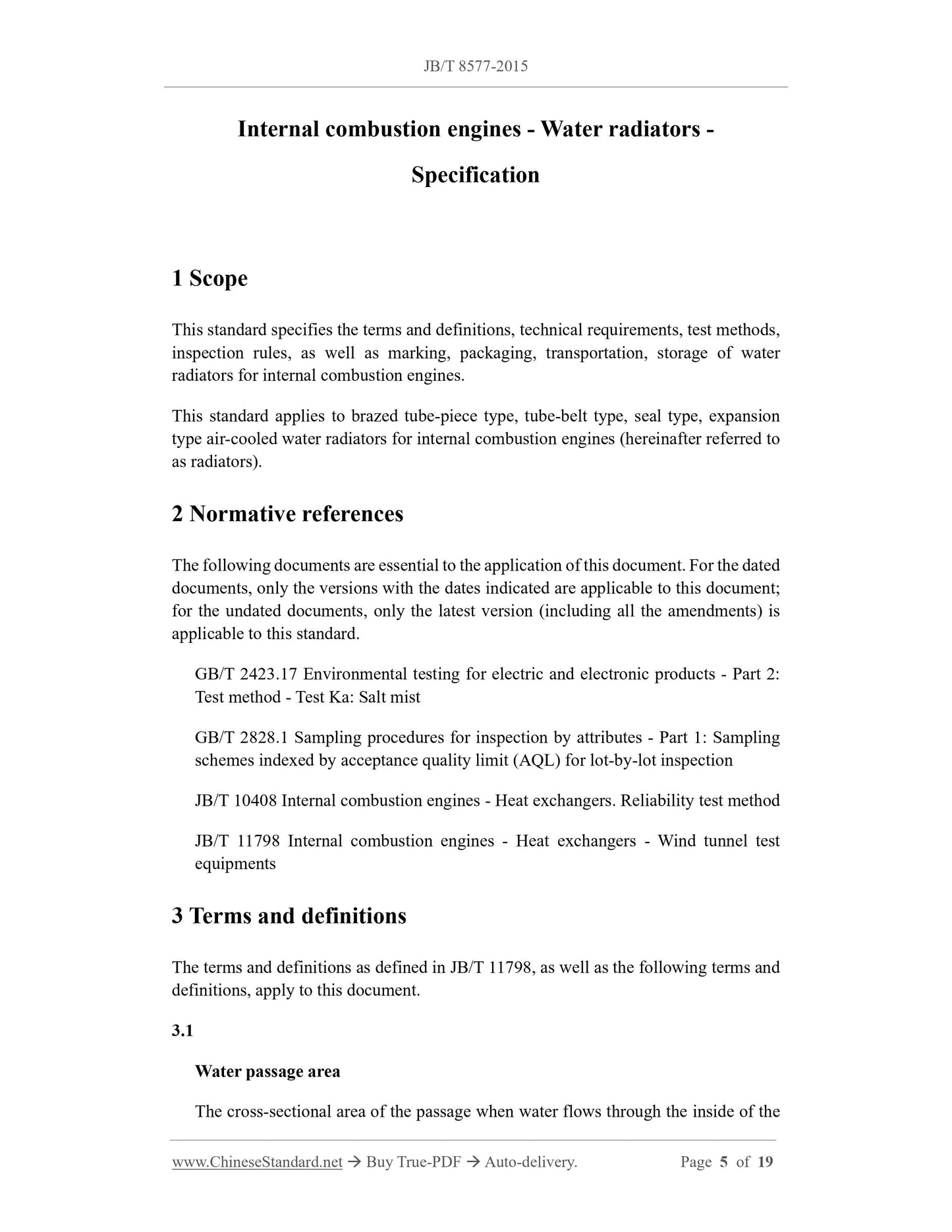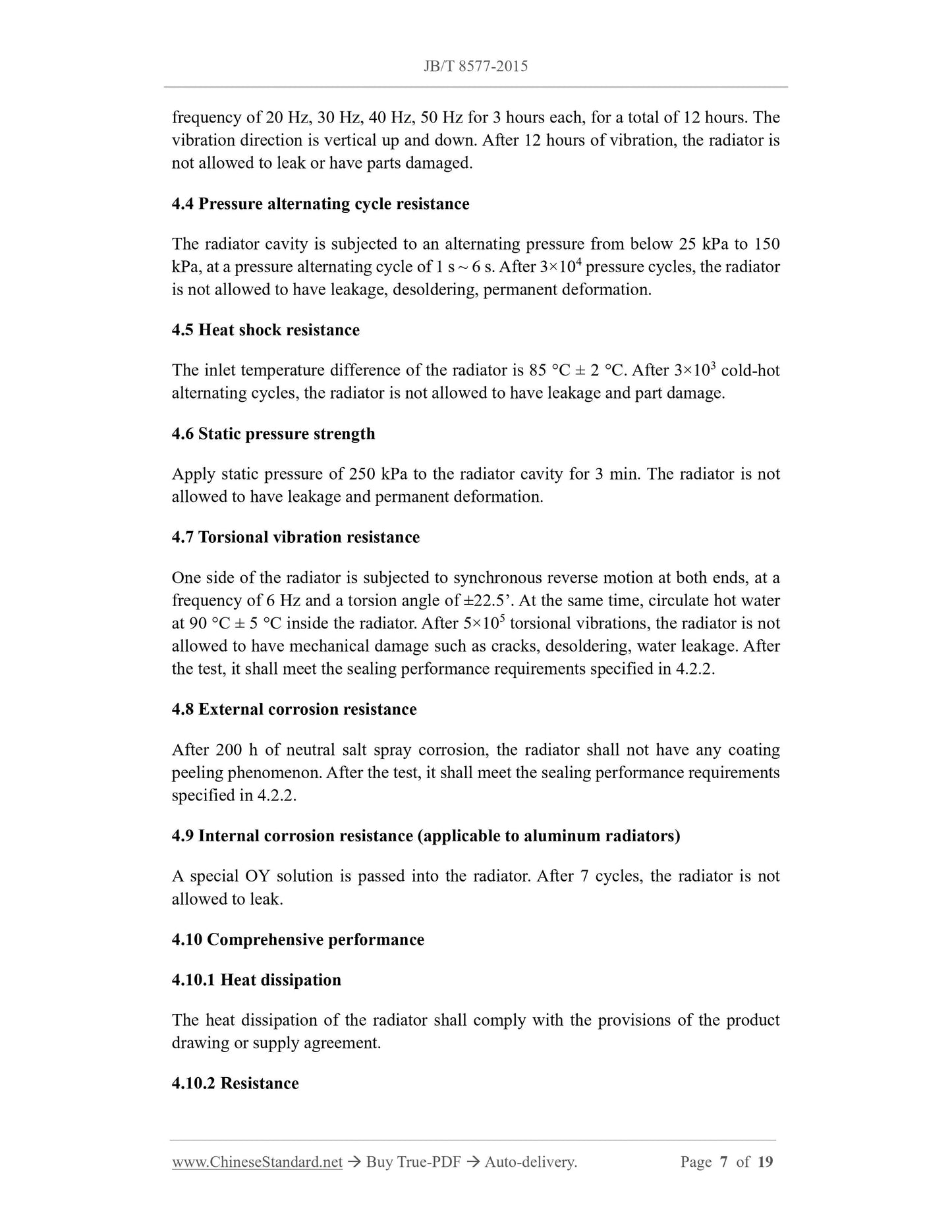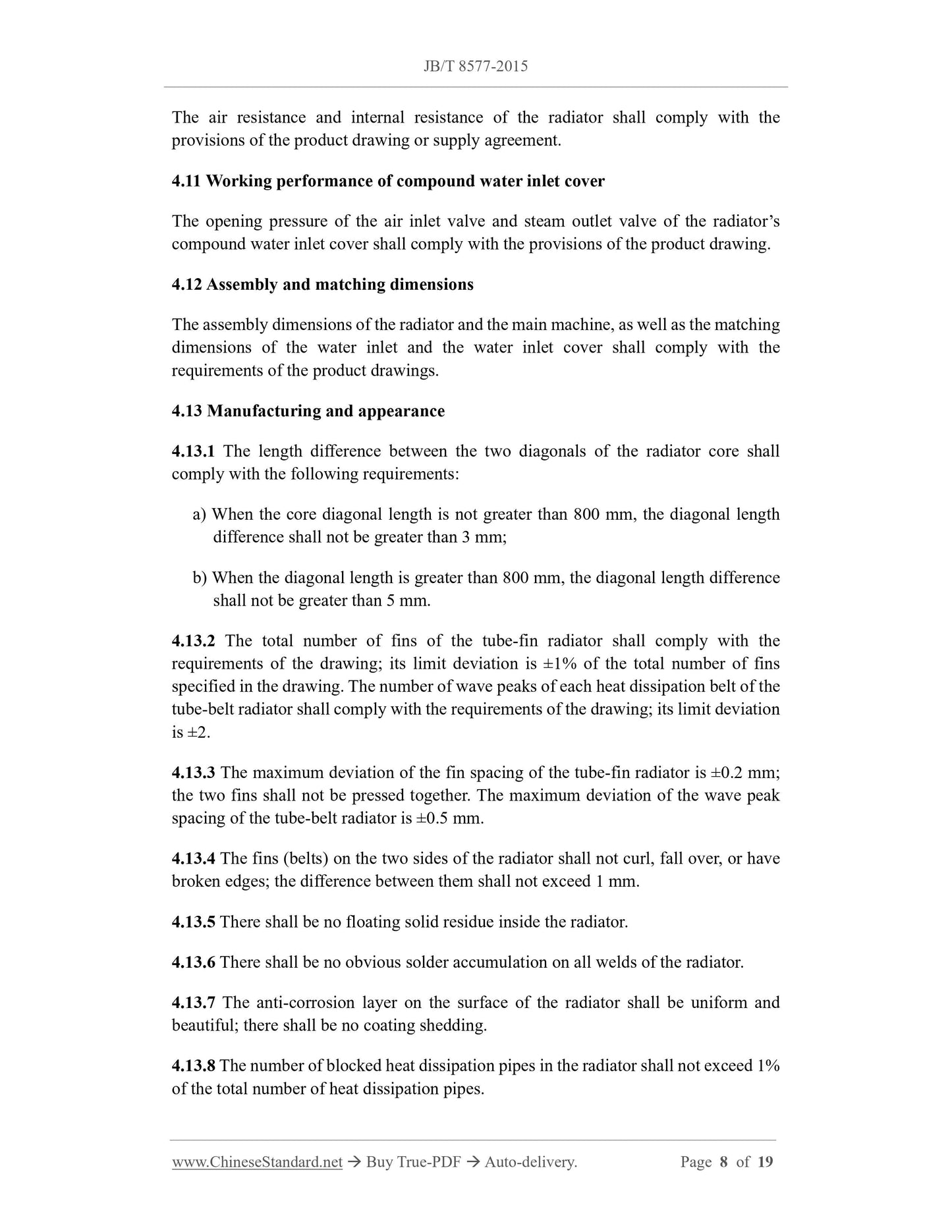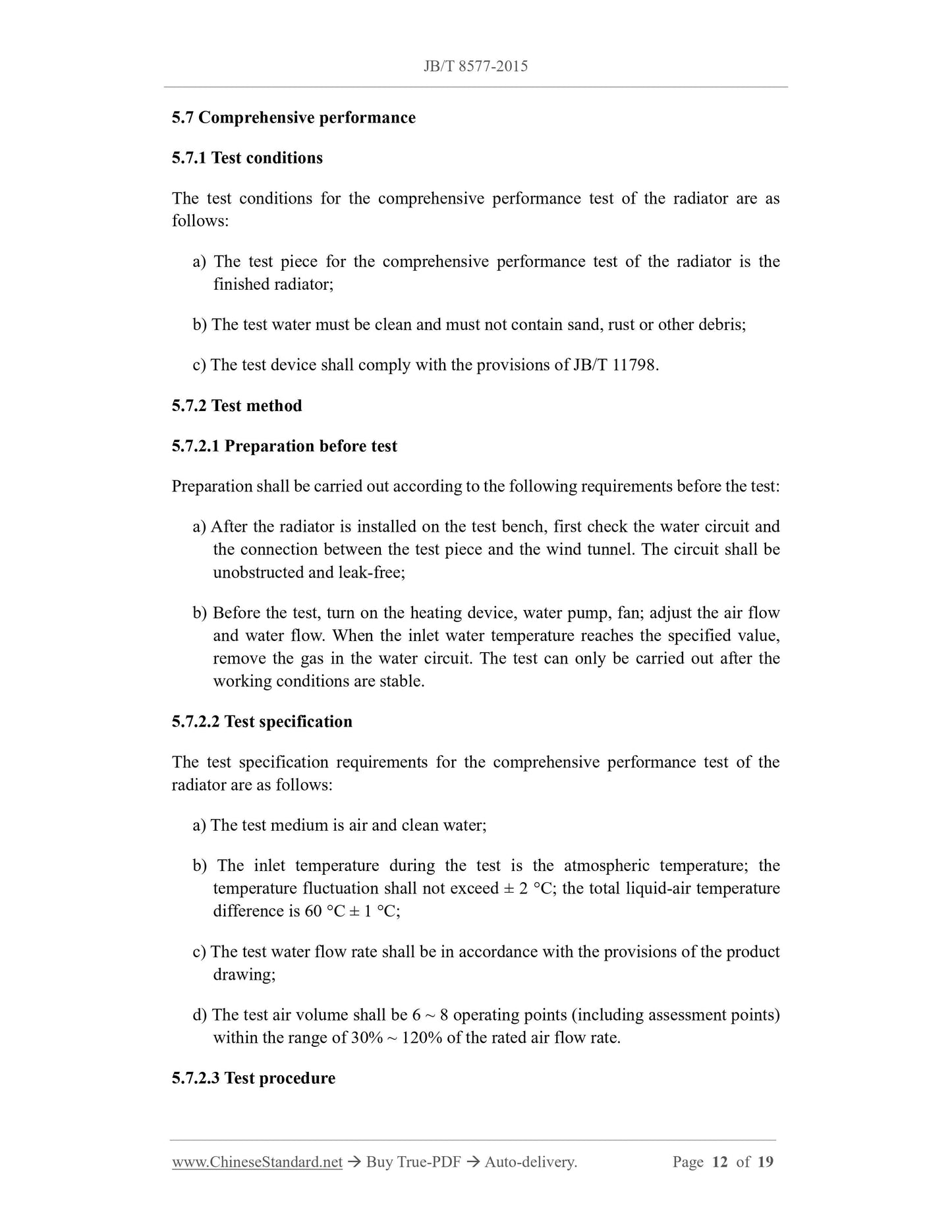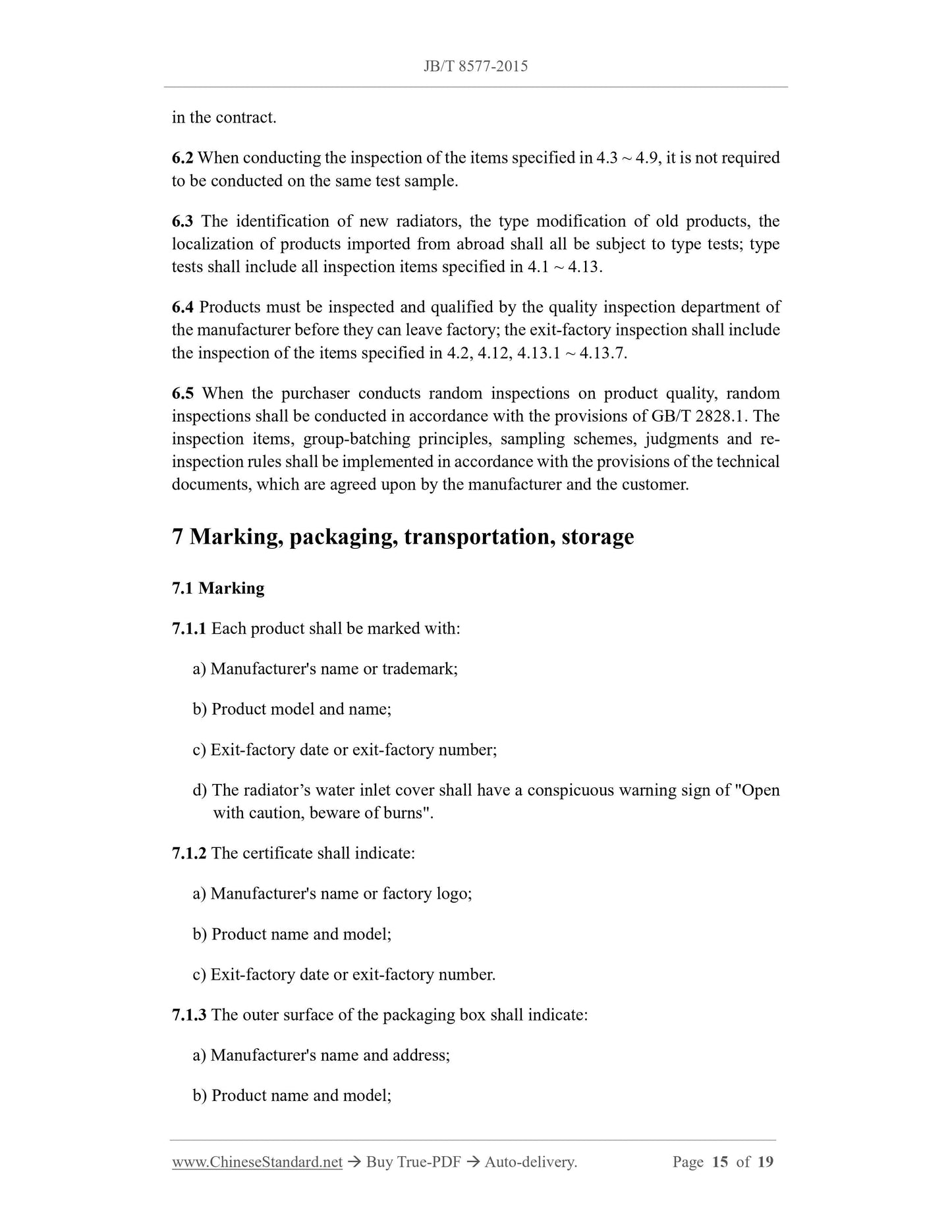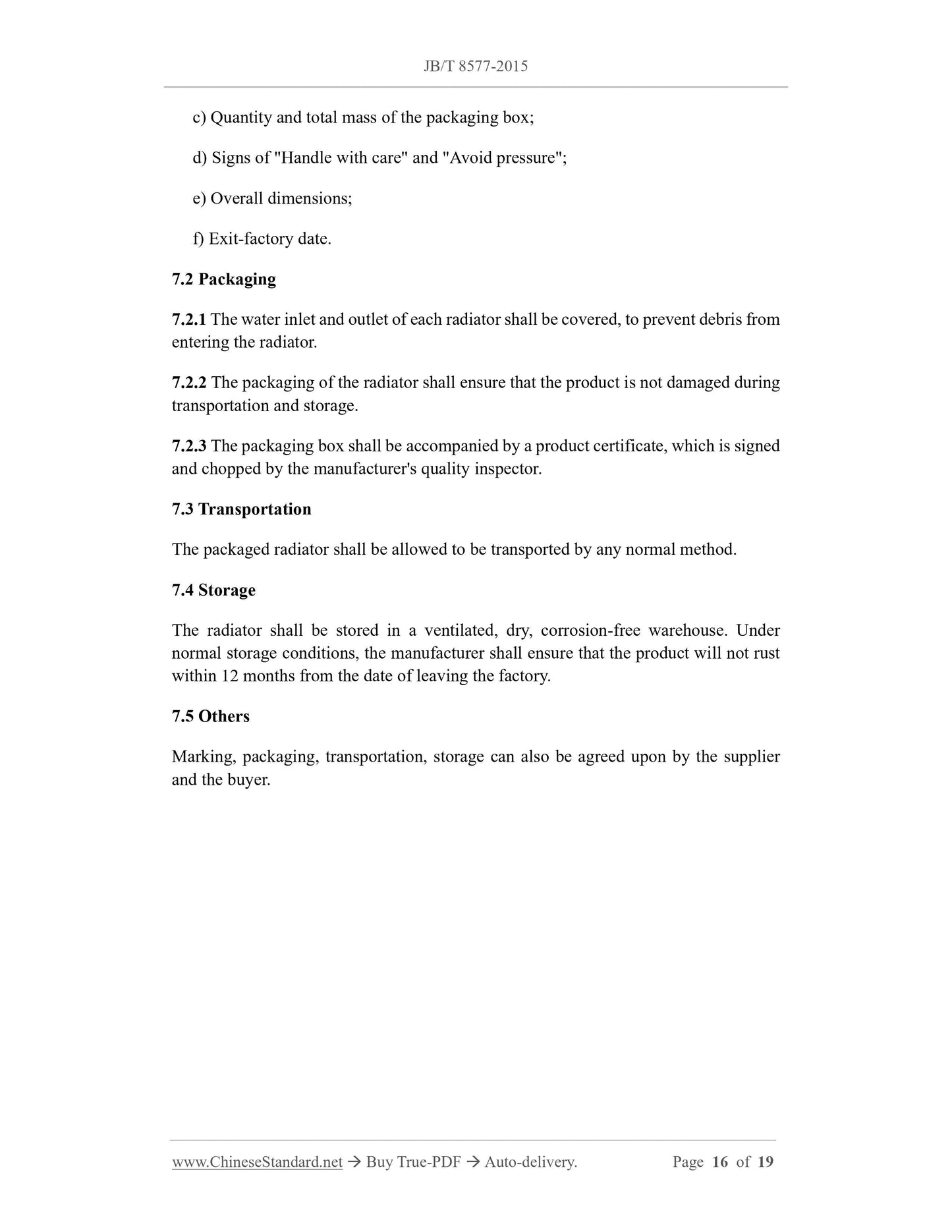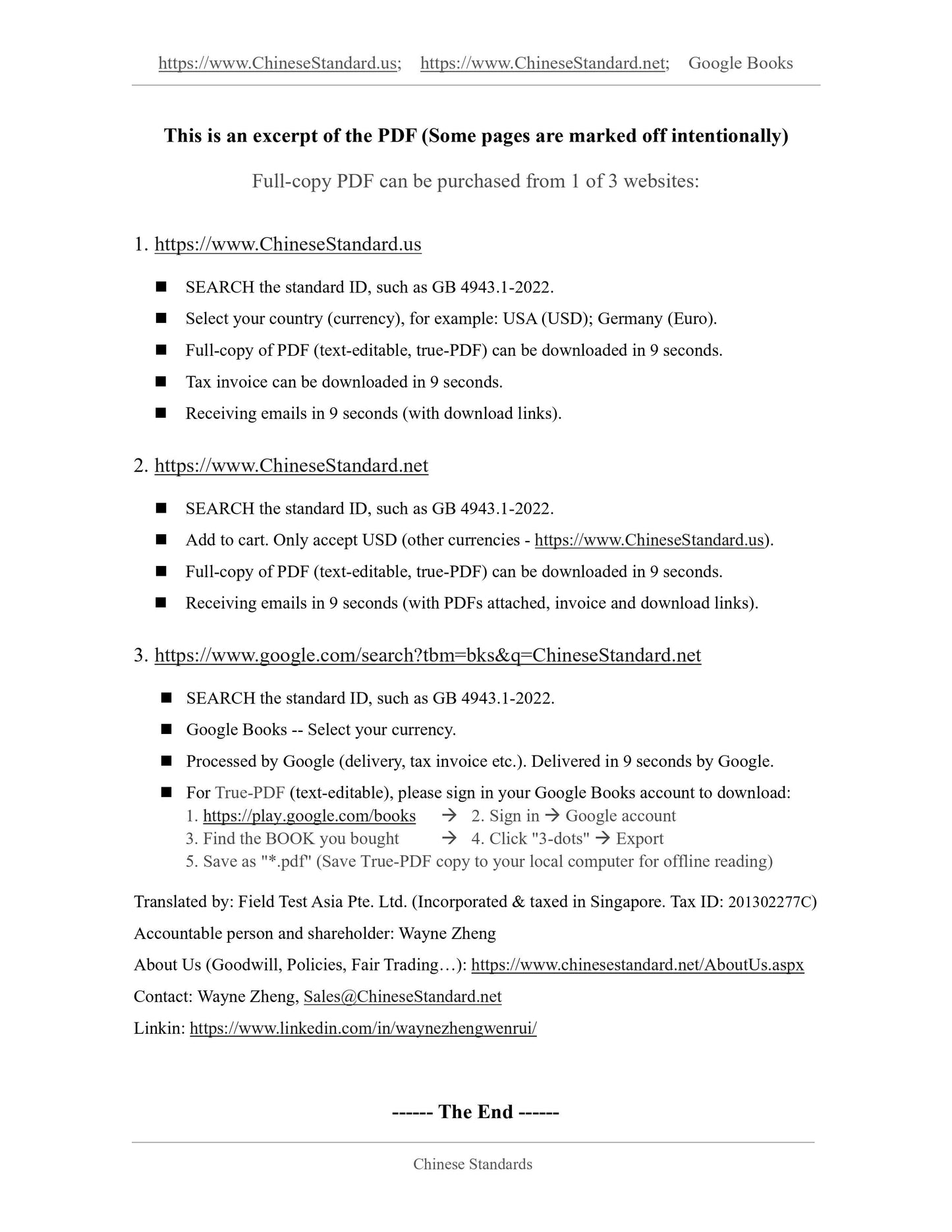1
/
of
9
www.ChineseStandard.us -- Field Test Asia Pte. Ltd.
JB/T 8577-2015 English PDF (JB/T8577-2015)
JB/T 8577-2015 English PDF (JB/T8577-2015)
Regular price
$310.00
Regular price
Sale price
$310.00
Unit price
/
per
Shipping calculated at checkout.
Couldn't load pickup availability
JB/T 8577-2015: Internal combustion engines - Water radiators - Specification
Delivery: 9 seconds. Download (& Email) true-PDF + Invoice.
Get Quotation: Click JB/T 8577-2015 (Self-service in 1-minute)
Historical versions (Master-website): JB/T 8577-2015
Preview True-PDF (Reload/Scroll-down if blank)
JB/T 8577-2015
JB
MECHANICAL INDUSTRY STANDARD
OF THE PEOPLE’S REPUBLIC OF CHINA
ICS 27.020
J 96
Filing No.: 51491-2015
Replacing JB/T 8577-2005
Internal combustion engines - Water radiators -
Specification
ISSUED ON: OCTOBER 10, 2015
IMPLEMENTED ON: MARCH 01, 2016
Issued by: Ministry of Industry and Information Technology of PRC
Table of Contents
Foreword ... 3
1 Scope ... 5
2 Normative references ... 5
3 Terms and definitions ... 5
4 Technical requirements ... 6
5 Test method ... 9
6 Inspection rules ... 14
7 Marking, packaging, transportation, storage ... 15
Appendix A (Normative) Calculation method of main structural parameters of internal
combustion engine’s water radiator ... 17
Appendix B (Informative) Original record sheet of neutral salt spray test ... 19
Internal combustion engines - Water radiators -
Specification
1 Scope
This standard specifies the terms and definitions, technical requirements, test methods,
inspection rules, as well as marking, packaging, transportation, storage of water
radiators for internal combustion engines.
This standard applies to brazed tube-piece type, tube-belt type, seal type, expansion
type air-cooled water radiators for internal combustion engines (hereinafter referred to
as radiators).
2 Normative references
The following documents are essential to the application of this document. For the dated
documents, only the versions with the dates indicated are applicable to this document;
for the undated documents, only the latest version (including all the amendments) is
applicable to this standard.
GB/T 2423.17 Environmental testing for electric and electronic products - Part 2:
Test method - Test Ka: Salt mist
GB/T 2828.1 Sampling procedures for inspection by attributes - Part 1: Sampling
schemes indexed by acceptance quality limit (AQL) for lot-by-lot inspection
JB/T 10408 Internal combustion engines - Heat exchangers. Reliability test method
JB/T 11798 Internal combustion engines - Heat exchangers - Wind tunnel test
equipments
3 Terms and definitions
The terms and definitions as defined in JB/T 11798, as well as the following terms and
definitions, apply to this document.
3.1
Water passage area
The cross-sectional area of the passage when water flows through the inside of the
frequency of 20 Hz, 30 Hz, 40 Hz, 50 Hz for 3 hours each, for a total of 12 hours. The
vibration direction is vertical up and down. After 12 hours of vibration, the radiator is
not allowed to leak or have parts damaged.
4.4 Pressure alternating cycle resistance
The radiator cavity is subjected to an alternating pressure from below 25 kPa to 150
kPa, at a pressure alternating cycle of 1 s ~ 6 s. After 3×104 pressure cycles, the radiator
is not allowed to have leakage, desoldering, permanent deformation.
4.5 Heat shock resistance
The inlet temperature difference of the radiator is 85 °C ± 2 °C. After 3×103 cold-hot
alternating cycles, the radiator is not allowed to have leakage and part damage.
4.6 Static pressure strength
Apply static pressure of 250 kPa to the radiator cavity for 3 min. The radiator is not
allowed to have leakage and permanent deformation.
4.7 Torsional vibration resistance
One side of the radiator is subjected to synchronous reverse motion at both ends, at a
frequency of 6 Hz and a torsion angle of ±22.5’. At the same time, circulate hot water
at 90 °C ± 5 °C inside the radiator. After 5×105 torsional vibrations, the radiator is not
allowed to have mechanical damage such as cracks, desoldering, water leakage. After
the test, it shall meet the sealing performance requirements specified in 4.2.2.
4.8 External corrosion resistance
After 200 h of neutral salt spray corrosion, the radiator shall not have any coating
peeling phenomenon. After the test, it shall meet the sealing performance requirements
specified in 4.2.2.
4.9 Internal corrosion resistance (applicable to aluminum radiators)
A special OY solution is passed into the radiator. After 7 cycles, the radiator is not
allowed to leak.
4.10 Comprehensive performance
4.10.1 Heat dissipation
The heat dissipation of the radiator shall comply with the provisions of the product
drawing or supply agreement.
4.10.2 Resistance
The air resistance and internal resistance of the radiator shall comply with the
provisions of the product drawing or supply agreement.
4.11 Working performance of compound water inlet cover
The opening pressure of the air inlet valve and steam outlet valve of the radiator’s
compound water inlet cover shall comply with the provisions of the product drawing.
4.12 Assembly and matching dimensions
The assembly dimensions of the radiator and the main machine, as well as the matching
dimensions of the water inlet and the water inlet cover shall comply with the
requirements of the product drawings.
4.13 Manufacturing and appearance
4.13.1 The length difference between the two diagonals of the radiator core shall
comply with the following requirements:
a) When the core diagonal length is not greater than 800 mm, the diagonal length
difference shall not be greater than 3 mm;
b) When the diagonal length is greater than 800 mm, the diagonal length difference
shall not be greater than 5 mm.
4.13.2 The total number of fins of the tube-fin radiator shall comply with the
requirements of the drawing; its limit deviation is ±1% of the total number of fins
specified in the drawing. The number of wave peaks of each heat dissipation belt of the
tube-belt radiator shall comply with the requirements of the drawing; its limit deviation
is ±2.
4.13.3 The maximum deviation of the fin spacing of the tube-fin radiator is ±0.2 mm;
the two fins shall not be pressed together. The maximum deviation of the wave peak
spacing of the tube-belt radiator is ±0.5 mm.
4.13.4 The fins (belts) on the two sides of the radiator shall not curl, fall over, or have
broken edges; the difference between them shall not exceed 1 mm.
4.13.5 There shall be no floating solid residue inside the radiator.
4.13.6 There shall be no obvious solder accumulation on all welds of the radiator.
4.13.7 The anti-corrosion layer on the surface of the radiator shall be uniform and
beautiful; there shall be no coating shedding.
4.13.8 The number of blocked heat dissipation pipes in the radiator shall not exceed 1%
of the total number of heat dissipation pipes.
5.7 Comprehensive performance
5.7.1 Test conditions
The test conditions for the comprehensive performance test of the radiator are as
follows:
a) The test piece for the comprehensive performance test of the radiator is the
finished radiator;
b) The test water must be clean and must not contain sand, rust or other debris;
c) The test device shall comply with the provisions of JB/T 11798.
5.7.2 Test method
5.7.2.1 Preparation before test
Preparation shall be carried out according to the following requirements before the test:
a) After the radiator is installed on the test bench, first check the water circuit and
the connection between the test piece and the wind tunnel. The circuit shall be
unobstructed and leak-free;
b) Before the test, turn on the heating device, water pump, fan; adjust the air flow
and water flow. When the inlet water temperature reaches the specified value,
remove the gas in the water circuit. The test can only be carried out after the
working conditions are stable.
5.7.2.2 Test specification
The test specification requirements for the comprehensive performance test of the
radiator are as follows:
a) The test medium is air and clean water;
b) The inlet temperature during the test is the atmospheric temperature; the
temperature fluctuation shall not exceed ± 2 °C; the total liquid-air temperature
difference is 60 °C ± 1 °C;
c) The test water flow rate shall be in accordance with the provisions of the product
drawing;
d) The test air volume shall be 6 ~ 8 operating points (including assessment points)
within the range of 30% ~ 120% of the rated air flow rate.
5.7.2.3 Test procedure
in the contract.
6.2 When conducting the inspection of the items specified in 4.3 ~ 4.9, it is not required
to be conducted on the same test sample.
6.3 The identification of new radiators, the type modification of old products, the
localization of products imported from abroad shall all be subject to type tests; type
tests shall include all inspection items specified in 4.1 ~ 4.13.
6.4 Products must be inspected and qualified by the quality inspection department of
the manufacturer before they can leave factory; the exit-factory inspection shall include
the inspection of the items specified in 4.2, 4.12, 4.13.1 ~ 4.13.7.
6.5 When the purchaser conducts random inspections on product quality, random
inspections shall be conducted in accordance with the provisions of GB/T 2828.1. The
inspection items, group-batching principles, sampling schemes, judgments and re-
inspection rules shall be implemented in accordance with the provisions of the technical
documents, which are agreed upon by the manufacturer and the customer.
7 Marking, packaging, transportation, storage
7.1 Marking
7.1.1 Each product shall be marked with:
a) Manufacturer's name or trademark;
b) Product model and name;
c) Exit-factory date or exit-factory number;
d) The radiator’s water inlet cover shall have a conspicuous warning sign of "Open
with caution, beware of burns".
7.1.2 The certificate shall indicate:
a) Manufacturer's name or factory logo;
b) Product name and model;
c) Exit-factory date or exit-factory number.
7.1.3 The outer surface of the packaging box shall indicate:
a) Manufacturer's name and address;
b) Product name and model;
c) Quantity and total mass of the packaging box;
d) Signs of "Handle with care" and "Avoid pressure";
e) Overall dimensions;
f) Exit-factory date.
7.2 Packaging
7.2.1 The water inlet and outlet of each radiator shall be covered, to prevent debris from
entering the radiator.
7.2.2 The packaging of the radiator shall ensure that the product is not damaged during
transportation and storage.
7.2.3 The packaging box shall be accompanied by a product certificate, which is signed
and chopped by the manufacturer's quality inspector.
7.3 Transportation
The packaged radiator shall be allowed to be transported by any normal method.
7.4 Storage
The radiator shall be stored in a ventilated, dry, corrosion-free warehouse. Under
normal storage conditions, the manufacturer shall ensure that the product will not rust
within 12 months from the date of leaving the factory.
7.5 Others
Marking, packaging, transportation, storage can also be agreed upon by the supplier
and the buyer.
JB/T 8577-2015
JB
MECHANICAL INDUSTRY STANDARD
OF THE PEOPLE’S REPUBLIC OF CHINA
ICS 27.020
J 96
Filing No.: 51491-2015
Replacing JB/T 8577-2005
Internal combustion engines - Water radiators -
Specification
ISSUED ON: OCTOBER 10, 2015
IMPLEMENTED ON: MARCH 01, 2016
Issued by: Ministry of Industry and Information Technology of PRC
Table of Contents
Foreword ... 3
1 Scope ... 5
2 Normative references ... 5
3 Terms and definitions ... 5
4 Technical requirements ... 6
5 Test method ... 9
6 Inspection rules ... 14
7 Marking, packaging, transportation, storage ... 15
Appendix A (Normative) Calculation method of main structural parameters of internal
combustion engine’s water radiator ... 17
Appendix B (Informative) Original record sheet of neutral salt spray test ... 19
Internal combustion engines - Water radiators -
Specification
1 Scope
This standard specifies the terms and definitions, technical requirements, test methods,
inspection rules, as well as marking, packaging, transportation, storage of water
radiators for internal combustion engines.
This standard applies to brazed tube-piece type, tube-belt type, seal type, expansion
type air-cooled water radiators for internal combustion engines (hereinafter referred to
as radiators).
2 Normative references
The following documents are essential to the application of this document. For the dated
documents, only the versions with the dates indicated are applicable to this document;
for the undated documents, only the latest version (including all the amendments) is
applicable to this standard.
GB/T 2423.17 Environmental testing for electric and electronic products - Part 2:
Test method - Test Ka: Salt mist
GB/T 2828.1 Sampling procedures for inspection by attributes - Part 1: Sampling
schemes indexed by acceptance quality limit (AQL) for lot-by-lot inspection
JB/T 10408 Internal combustion engines - Heat exchangers. Reliability test method
JB/T 11798 Internal combustion engines - Heat exchangers - Wind tunnel test
equipments
3 Terms and definitions
The terms and definitions as defined in JB/T 11798, as well as the following terms and
definitions, apply to this document.
3.1
Water passage area
The cross-sectional area of the passage when water flows through the inside of the
frequency of 20 Hz, 30 Hz, 40 Hz, 50 Hz for 3 hours each, for a total of 12 hours. The
vibration direction is vertical up and down. After 12 hours of vibration, the radiator is
not allowed to leak or have parts damaged.
4.4 Pressure alternating cycle resistance
The radiator cavity is subjected to an alternating pressure from below 25 kPa to 150
kPa, at a pressure alternating cycle of 1 s ~ 6 s. After 3×104 pressure cycles, the radiator
is not allowed to have leakage, desoldering, permanent deformation.
4.5 Heat shock resistance
The inlet temperature difference of the radiator is 85 °C ± 2 °C. After 3×103 cold-hot
alternating cycles, the radiator is not allowed to have leakage and part damage.
4.6 Static pressure strength
Apply static pressure of 250 kPa to the radiator cavity for 3 min. The radiator is not
allowed to have leakage and permanent deformation.
4.7 Torsional vibration resistance
Delivery: 9 seconds. Download (& Email) true-PDF + Invoice.
Get Quotation: Click JB/T 8577-2015 (Self-service in 1-minute)
Historical versions (Master-website): JB/T 8577-2015
Preview True-PDF (Reload/Scroll-down if blank)
JB/T 8577-2015
JB
MECHANICAL INDUSTRY STANDARD
OF THE PEOPLE’S REPUBLIC OF CHINA
ICS 27.020
J 96
Filing No.: 51491-2015
Replacing JB/T 8577-2005
Internal combustion engines - Water radiators -
Specification
ISSUED ON: OCTOBER 10, 2015
IMPLEMENTED ON: MARCH 01, 2016
Issued by: Ministry of Industry and Information Technology of PRC
Table of Contents
Foreword ... 3
1 Scope ... 5
2 Normative references ... 5
3 Terms and definitions ... 5
4 Technical requirements ... 6
5 Test method ... 9
6 Inspection rules ... 14
7 Marking, packaging, transportation, storage ... 15
Appendix A (Normative) Calculation method of main structural parameters of internal
combustion engine’s water radiator ... 17
Appendix B (Informative) Original record sheet of neutral salt spray test ... 19
Internal combustion engines - Water radiators -
Specification
1 Scope
This standard specifies the terms and definitions, technical requirements, test methods,
inspection rules, as well as marking, packaging, transportation, storage of water
radiators for internal combustion engines.
This standard applies to brazed tube-piece type, tube-belt type, seal type, expansion
type air-cooled water radiators for internal combustion engines (hereinafter referred to
as radiators).
2 Normative references
The following documents are essential to the application of this document. For the dated
documents, only the versions with the dates indicated are applicable to this document;
for the undated documents, only the latest version (including all the amendments) is
applicable to this standard.
GB/T 2423.17 Environmental testing for electric and electronic products - Part 2:
Test method - Test Ka: Salt mist
GB/T 2828.1 Sampling procedures for inspection by attributes - Part 1: Sampling
schemes indexed by acceptance quality limit (AQL) for lot-by-lot inspection
JB/T 10408 Internal combustion engines - Heat exchangers. Reliability test method
JB/T 11798 Internal combustion engines - Heat exchangers - Wind tunnel test
equipments
3 Terms and definitions
The terms and definitions as defined in JB/T 11798, as well as the following terms and
definitions, apply to this document.
3.1
Water passage area
The cross-sectional area of the passage when water flows through the inside of the
frequency of 20 Hz, 30 Hz, 40 Hz, 50 Hz for 3 hours each, for a total of 12 hours. The
vibration direction is vertical up and down. After 12 hours of vibration, the radiator is
not allowed to leak or have parts damaged.
4.4 Pressure alternating cycle resistance
The radiator cavity is subjected to an alternating pressure from below 25 kPa to 150
kPa, at a pressure alternating cycle of 1 s ~ 6 s. After 3×104 pressure cycles, the radiator
is not allowed to have leakage, desoldering, permanent deformation.
4.5 Heat shock resistance
The inlet temperature difference of the radiator is 85 °C ± 2 °C. After 3×103 cold-hot
alternating cycles, the radiator is not allowed to have leakage and part damage.
4.6 Static pressure strength
Apply static pressure of 250 kPa to the radiator cavity for 3 min. The radiator is not
allowed to have leakage and permanent deformation.
4.7 Torsional vibration resistance
One side of the radiator is subjected to synchronous reverse motion at both ends, at a
frequency of 6 Hz and a torsion angle of ±22.5’. At the same time, circulate hot water
at 90 °C ± 5 °C inside the radiator. After 5×105 torsional vibrations, the radiator is not
allowed to have mechanical damage such as cracks, desoldering, water leakage. After
the test, it shall meet the sealing performance requirements specified in 4.2.2.
4.8 External corrosion resistance
After 200 h of neutral salt spray corrosion, the radiator shall not have any coating
peeling phenomenon. After the test, it shall meet the sealing performance requirements
specified in 4.2.2.
4.9 Internal corrosion resistance (applicable to aluminum radiators)
A special OY solution is passed into the radiator. After 7 cycles, the radiator is not
allowed to leak.
4.10 Comprehensive performance
4.10.1 Heat dissipation
The heat dissipation of the radiator shall comply with the provisions of the product
drawing or supply agreement.
4.10.2 Resistance
The air resistance and internal resistance of the radiator shall comply with the
provisions of the product drawing or supply agreement.
4.11 Working performance of compound water inlet cover
The opening pressure of the air inlet valve and steam outlet valve of the radiator’s
compound water inlet cover shall comply with the provisions of the product drawing.
4.12 Assembly and matching dimensions
The assembly dimensions of the radiator and the main machine, as well as the matching
dimensions of the water inlet and the water inlet cover shall comply with the
requirements of the product drawings.
4.13 Manufacturing and appearance
4.13.1 The length difference between the two diagonals of the radiator core shall
comply with the following requirements:
a) When the core diagonal length is not greater than 800 mm, the diagonal length
difference shall not be greater than 3 mm;
b) When the diagonal length is greater than 800 mm, the diagonal length difference
shall not be greater than 5 mm.
4.13.2 The total number of fins of the tube-fin radiator shall comply with the
requirements of the drawing; its limit deviation is ±1% of the total number of fins
specified in the drawing. The number of wave peaks of each heat dissipation belt of the
tube-belt radiator shall comply with the requirements of the drawing; its limit deviation
is ±2.
4.13.3 The maximum deviation of the fin spacing of the tube-fin radiator is ±0.2 mm;
the two fins shall not be pressed together. The maximum deviation of the wave peak
spacing of the tube-belt radiator is ±0.5 mm.
4.13.4 The fins (belts) on the two sides of the radiator shall not curl, fall over, or have
broken edges; the difference between them shall not exceed 1 mm.
4.13.5 There shall be no floating solid residue inside the radiator.
4.13.6 There shall be no obvious solder accumulation on all welds of the radiator.
4.13.7 The anti-corrosion layer on the surface of the radiator shall be uniform and
beautiful; there shall be no coating shedding.
4.13.8 The number of blocked heat dissipation pipes in the radiator shall not exceed 1%
of the total number of heat dissipation pipes.
5.7 Comprehensive performance
5.7.1 Test conditions
The test conditions for the comprehensive performance test of the radiator are as
follows:
a) The test piece for the comprehensive performance test of the radiator is the
finished radiator;
b) The test water must be clean and must not contain sand, rust or other debris;
c) The test device shall comply with the provisions of JB/T 11798.
5.7.2 Test method
5.7.2.1 Preparation before test
Preparation shall be carried out according to the following requirements before the test:
a) After the radiator is installed on the test bench, first check the water circuit and
the connection between the test piece and the wind tunnel. The circuit shall be
unobstructed and leak-free;
b) Before the test, turn on the heating device, water pump, fan; adjust the air flow
and water flow. When the inlet water temperature reaches the specified value,
remove the gas in the water circuit. The test can only be carried out after the
working conditions are stable.
5.7.2.2 Test specification
The test specification requirements for the comprehensive performance test of the
radiator are as follows:
a) The test medium is air and clean water;
b) The inlet temperature during the test is the atmospheric temperature; the
temperature fluctuation shall not exceed ± 2 °C; the total liquid-air temperature
difference is 60 °C ± 1 °C;
c) The test water flow rate shall be in accordance with the provisions of the product
drawing;
d) The test air volume shall be 6 ~ 8 operating points (including assessment points)
within the range of 30% ~ 120% of the rated air flow rate.
5.7.2.3 Test procedure
in the contract.
6.2 When conducting the inspection of the items specified in 4.3 ~ 4.9, it is not required
to be conducted on the same test sample.
6.3 The identification of new radiators, the type modification of old products, the
localization of products imported from abroad shall all be subject to type tests; type
tests shall include all inspection items specified in 4.1 ~ 4.13.
6.4 Products must be inspected and qualified by the quality inspection department of
the manufacturer before they can leave factory; the exit-factory inspection shall include
the inspection of the items specified in 4.2, 4.12, 4.13.1 ~ 4.13.7.
6.5 When the purchaser conducts random inspections on product quality, random
inspections shall be conducted in accordance with the provisions of GB/T 2828.1. The
inspection items, group-batching principles, sampling schemes, judgments and re-
inspection rules shall be implemented in accordance with the provisions of the technical
documents, which are agreed upon by the manufacturer and the customer.
7 Marking, packaging, transportation, storage
7.1 Marking
7.1.1 Each product shall be marked with:
a) Manufacturer's name or trademark;
b) Product model and name;
c) Exit-factory date or exit-factory number;
d) The radiator’s water inlet cover shall have a conspicuous warning sign of "Open
with caution, beware of burns".
7.1.2 The certificate shall indicate:
a) Manufacturer's name or factory logo;
b) Product name and model;
c) Exit-factory date or exit-factory number.
7.1.3 The outer surface of the packaging box shall indicate:
a) Manufacturer's name and address;
b) Product name and model;
c) Quantity and total mass of the packaging box;
d) Signs of "Handle with care" and "Avoid pressure";
e) Overall dimensions;
f) Exit-factory date.
7.2 Packaging
7.2.1 The water inlet and outlet of each radiator shall be covered, to prevent debris from
entering the radiator.
7.2.2 The packaging of the radiator shall ensure that the product is not damaged during
transportation and storage.
7.2.3 The packaging box shall be accompanied by a product certificate, which is signed
and chopped by the manufacturer's quality inspector.
7.3 Transportation
The packaged radiator shall be allowed to be transported by any normal method.
7.4 Storage
The radiator shall be stored in a ventilated, dry, corrosion-free warehouse. Under
normal storage conditions, the manufacturer shall ensure that the product will not rust
within 12 months from the date of leaving the factory.
7.5 Others
Marking, packaging, transportation, storage can also be agreed upon by the supplier
and the buyer.
JB/T 8577-2015
JB
MECHANICAL INDUSTRY STANDARD
OF THE PEOPLE’S REPUBLIC OF CHINA
ICS 27.020
J 96
Filing No.: 51491-2015
Replacing JB/T 8577-2005
Internal combustion engines - Water radiators -
Specification
ISSUED ON: OCTOBER 10, 2015
IMPLEMENTED ON: MARCH 01, 2016
Issued by: Ministry of Industry and Information Technology of PRC
Table of Contents
Foreword ... 3
1 Scope ... 5
2 Normative references ... 5
3 Terms and definitions ... 5
4 Technical requirements ... 6
5 Test method ... 9
6 Inspection rules ... 14
7 Marking, packaging, transportation, storage ... 15
Appendix A (Normative) Calculation method of main structural parameters of internal
combustion engine’s water radiator ... 17
Appendix B (Informative) Original record sheet of neutral salt spray test ... 19
Internal combustion engines - Water radiators -
Specification
1 Scope
This standard specifies the terms and definitions, technical requirements, test methods,
inspection rules, as well as marking, packaging, transportation, storage of water
radiators for internal combustion engines.
This standard applies to brazed tube-piece type, tube-belt type, seal type, expansion
type air-cooled water radiators for internal combustion engines (hereinafter referred to
as radiators).
2 Normative references
The following documents are essential to the application of this document. For the dated
documents, only the versions with the dates indicated are applicable to this document;
for the undated documents, only the latest version (including all the amendments) is
applicable to this standard.
GB/T 2423.17 Environmental testing for electric and electronic products - Part 2:
Test method - Test Ka: Salt mist
GB/T 2828.1 Sampling procedures for inspection by attributes - Part 1: Sampling
schemes indexed by acceptance quality limit (AQL) for lot-by-lot inspection
JB/T 10408 Internal combustion engines - Heat exchangers. Reliability test method
JB/T 11798 Internal combustion engines - Heat exchangers - Wind tunnel test
equipments
3 Terms and definitions
The terms and definitions as defined in JB/T 11798, as well as the following terms and
definitions, apply to this document.
3.1
Water passage area
The cross-sectional area of the passage when water flows through the inside of the
frequency of 20 Hz, 30 Hz, 40 Hz, 50 Hz for 3 hours each, for a total of 12 hours. The
vibration direction is vertical up and down. After 12 hours of vibration, the radiator is
not allowed to leak or have parts damaged.
4.4 Pressure alternating cycle resistance
The radiator cavity is subjected to an alternating pressure from below 25 kPa to 150
kPa, at a pressure alternating cycle of 1 s ~ 6 s. After 3×104 pressure cycles, the radiator
is not allowed to have leakage, desoldering, permanent deformation.
4.5 Heat shock resistance
The inlet temperature difference of the radiator is 85 °C ± 2 °C. After 3×103 cold-hot
alternating cycles, the radiator is not allowed to have leakage and part damage.
4.6 Static pressure strength
Apply static pressure of 250 kPa to the radiator cavity for 3 min. The radiator is not
allowed to have leakage and permanent deformation.
4.7 Torsional vibration resistance
Share
